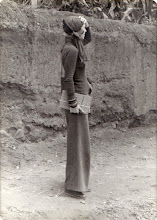After looking at the photographic postmodernism of the Pictures artists last week and getting caught up in the aesthetic underpinnings and criticisms involved in their treatment of authorship and subjecthood, Bourdieuconomics got me right back on the healthy track of disenchantment, getting right back to that all-encompassing art market, the key word being market.
Ironically, his theories on the disavowal of economic interestedness followed neatly with artists such as Prince's effacement of the authorial presence, and exit from representation. Take Marlboro man, mentioned above, in which Prince directly photographed the ad of the cowboy, "elevated in the public imagination from humble ranch hand to lone hero, the cowboy is an icon of American manhood”, a work which in some ways ironically aims to deny the glorification of commercial values. The artistic approach eliminates both the object initially sold by the image, and takes the image out of the "undisguised self-interest economy" and places it in the exceptional "non-profit" institution in the comprehensively for-profit 1st world economy.
This 'move' is as much Prince's appropriation of a popular image already imbued with a great deal of social and symbolic capital, as it involves the image's appropriation of his own accumulation of social capital and habitus - placing it among his other works, tied to his reputation and his rolodex, within an elevated realm of enlightened cultural values. Despite the theoretically low liquidity of art works, the record auction prices for photography held by Prince's work at the time and even now, show the accrued value involved in the economics of disavowal, raising their economic value immensely.
Furthermore, Prince's inclusion in the founding show of the Pictures generation, curated by a widely respected expert (Crimp) conferred a great deal of social, symbolic and cultural capital on his work - for his habitus, embodied in his person and thus in what he creates, institutionalized in the art world, and in history (or culture). The value of his work obviously amounts to much more than the accumulation of its parts - which his minimuseums, granted by the Guggenheim, can attest to.
Interestingly, although Prince's early works displaced the economic values of commodity culture in an effort to "undermine the manipulative strategies of the advertising industry", many of his works were and still are collected by large corporations such as AT&T, as both a symbol of prestige, an indicator of their taste as aligned if not a defining aspect of the dominant group, and as an investment.


Aucun commentaire:
Enregistrer un commentaire